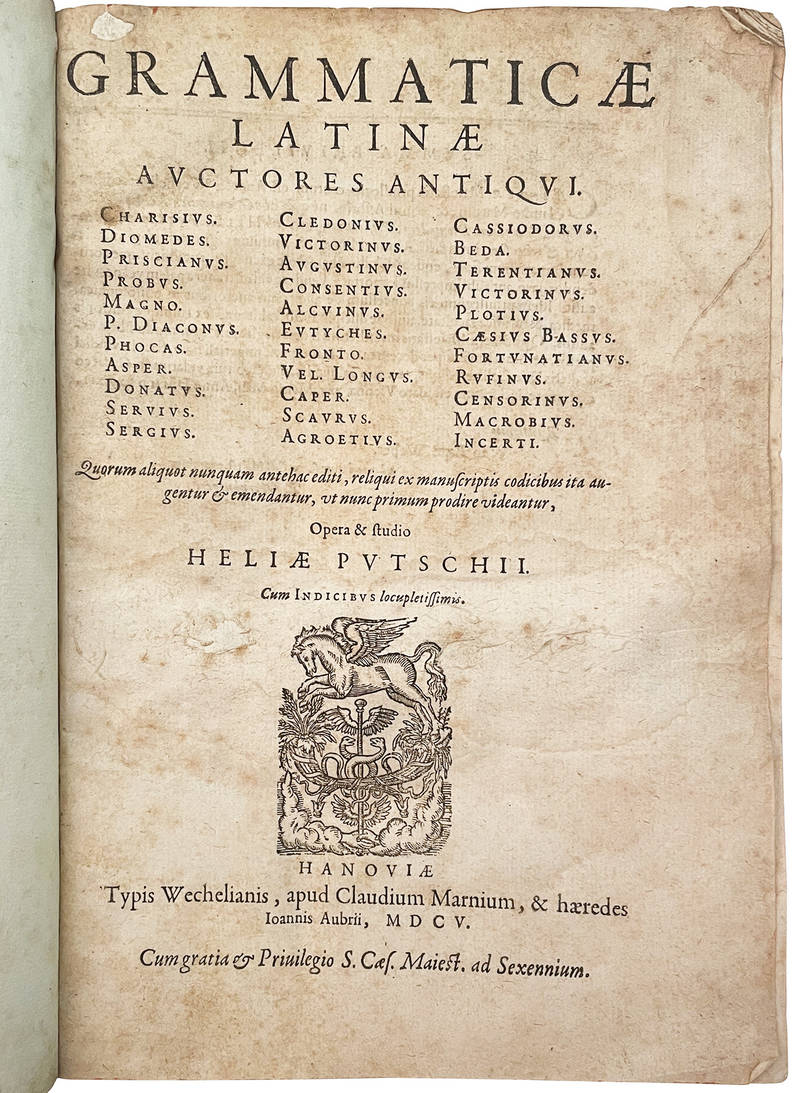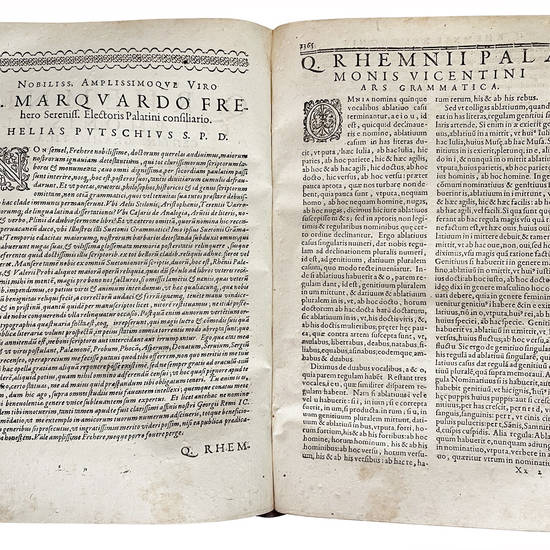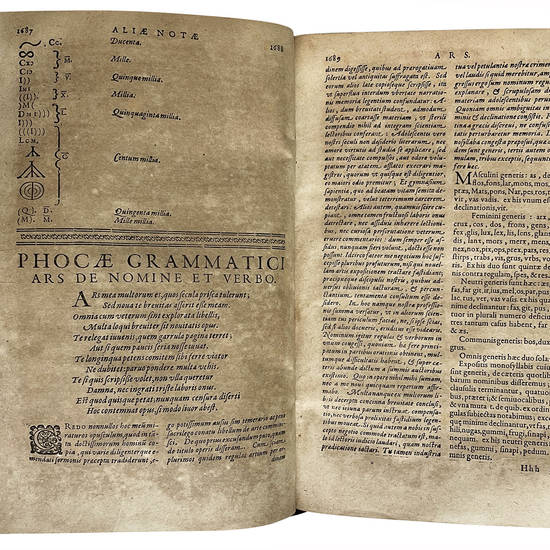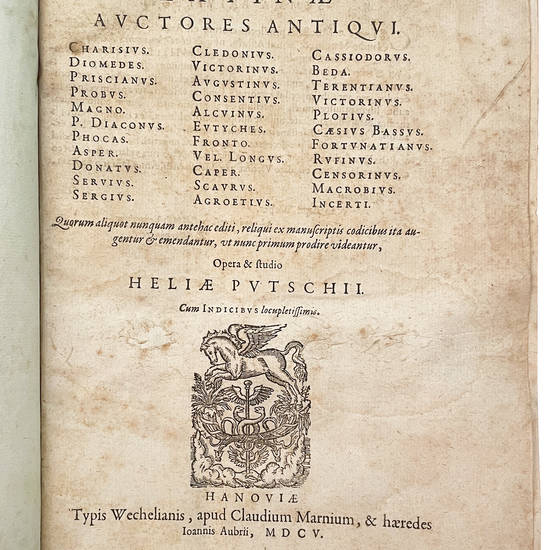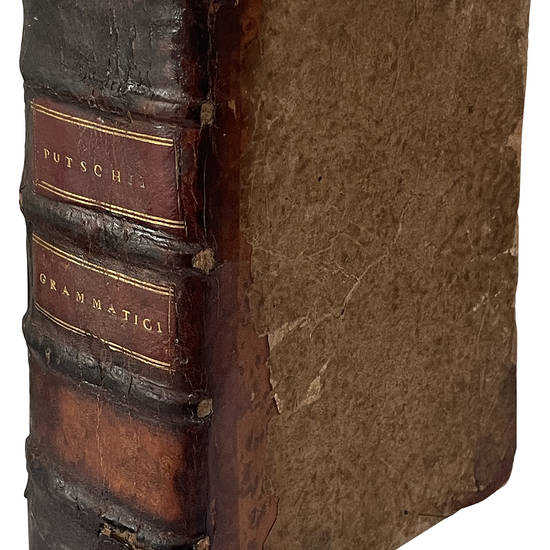Grammaticae Latinae Auctores Antiqui: Charisius. Diomedes. Priscianus. Probus. Magno. P. Diaconus. Phocas. Asper. Donatus. Servius. Sergius. Cledonius. Victorinus. Augustinus. Consentius. Alcuinus. Eutyches. Fronto. Vel. Longus. Caper. Scaurus. Agroetius. Cassiodorus. Beda. Terentianus. Victorinus. Plotius. Caesius Bassus. Fortunatianus. Rufinus. Censorinus. Macrobius. Incerti. Quorum aliquot nunquam antehac editi, reliqui ex manuscriptis codicibus ita augentur & emendantur, ut nunc primum prodire videantur, Opera & studio Heliae Putschii. Cum indicibvs locupletissimis
Autore: PUTSCHEN, Helias (1580-1606)
Tipografo: typis Wechelianis, apud Claudium Marnium, & haeredes Ioannis Aubrii (with the types of Andreas Wechel's heirs, Claude de Marne & Johann Aubry's heirs)
Dati tipografici: Hanau, 1605
Two parts in one volume, 4to (244x174 mm). [8] ll., 1-1358 cols., [1] p.; [1] l., 1365-2384 cols., 2385-2448 pp., 2449-2803 cols., [1] col., [39] ll. Collation: *-**4 A-Tt8 Vv4; Xx-Ccccc8. Printer's device depicting Pegasus on title page. Authors' names printed in three columns on the title page. On title-page verso printing privilege for Germany only (some copies also contain the privilege for France printed below on the same page). The works of each author are preceded by a divisional half title. Text in Latin with quotations and examples in Greek. Decorative initials, head- and tailpieces. Includes index. Later half calf, spine with four raised bands and double morocco lettering piece, red edges (spine partly restored, still worn and rubbed, in particular the corners and the top of the spine). Loss of paper to the lower margin of l. *4 not affecting the text, restorations to the verso of the title page not affecting the text, mostly browned due to the quality of the paper, some marginal staining.
First edition, divided in two parts, of this anthology of several grammatical works by 33 Latin grammarians, ten of which appear here for the first time, “ein für das Studium der lateinischen Sprache und ihrer Geschichte epochemachendes Werk, das ihm für alle Zeiten einen Ehrenplatz in der Geschichte der Philologie gesichert hat” (A.D.B., XXVI, 748).
The first part, dedicated to Joseph Justus Scaliger (1540-1609), the son of Julius Caesar, contains texts by the following authors: Flavius Sosipater Charisius (4th cent.), Diomedes Grammaticus (4th cent.), and Priscianus Caesarensis (5th-6th cent.).
The second, dedicated to Marquard Freher (1565-1614), contains texts by the following authors: Pseudus Quintus Remmius Palaemon (1st cent., here in 1st edition), Marcus Valerius Probus (ca. 20/30-105), Magnus (or Magno) Senonensis (748-818), Petrus Diaconus (ca. 1110-1159), Phocas Grammaticus (ca. 3rd-4th cent.), Asper Junior (5th cent.), Aelius Donatus (4th cent.), Marius Honoratus Servius (ca. 4th-5th cent.), Sergius Grammaticus (6th cent., here in 1st edition), Cledonius Grammaticus (5th cent., here in 1st edition), Maximus Victorinus (4th cent.?), Aurelius Augustinus (354-430), Consentius Grammaticus (5th cent., here in 1st edition), Flaccus Alcuinus (735-804), Euthyches Grammaticus (6th cent., here in 1st edition), Marcus Cornelius Fronto (100-170), Velius Longus (2nd cent., here in 1st edition), Flavius Caper (2nd cent., here in 1st edition), Quintus Terentius Scaurus (2nd cent.), Agroetius Senonensis (5th cent., here in 1st edition), Flavius Magnus Aurelius Cassiodorus (490-583), Beda Venerabilis (672-735, here in 1st edition), Terentianus Maurus (2nd-3rd cent.), Gaius Marius Victorinus (281-362), Marius Plotius Sacerdos (3rd-4th cent., here in 1st edition), Caesius Bassus (d. 79), Atilius Fortunatianus (4th cent.), Rufinus Antiochensis (4th-5th cent.), Censorinus (3rd cent.), and Ambrosius Aurelius Theodosius Macrobius (ca. 385-430).
Helias Putschen (or van Putschen), latinized in Putschius, was born in Antwerp in 1580. He dedicated his life to poetry and classical philology. His first significant contribution was an edition of Sallust printed in 1602. Three years later he published the Grammaticae latinae autores antiqui, which remained the reference work in the field for more than 250 years. Putschen used only manuscripts as sources for the texts he included in the collection, ten of which are here in first edition.
VD17, 7:664160B; cf. Schweiger, s.v.
[11559]

